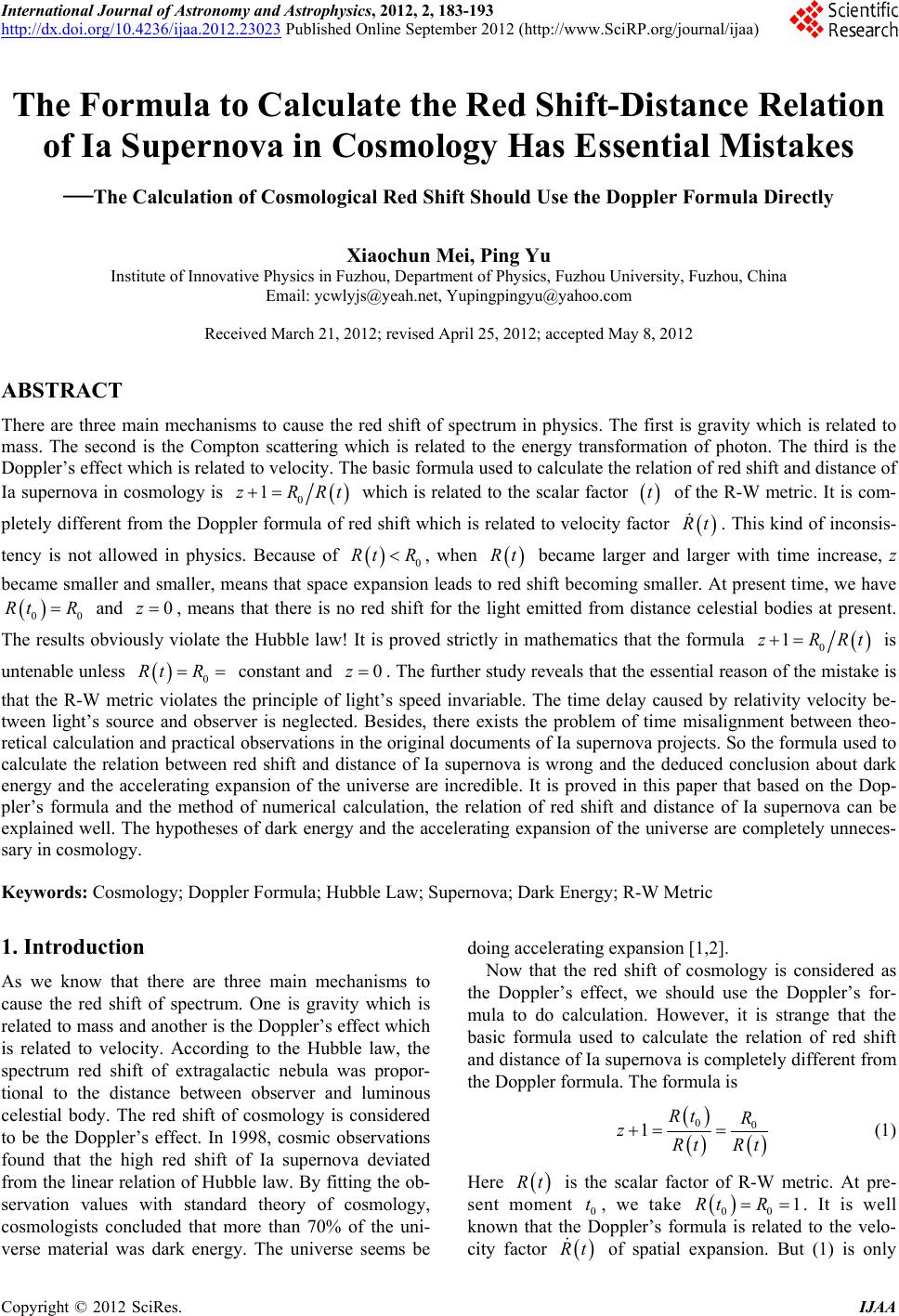 International Journal of Astronomy and Astrophysics, 2012, 2, 183-193 http://dx.doi.org/10.4236/ijaa.2012.23023 Published Online September 2012 (http://www.SciRP.org/journal/ijaa) The Formula to Calculate the Red Shift-Distance Relation of Ia Supernova in Cosmology Has Essential Mistakes —The Calculation of Cosmological Red Shift Should Use the Doppler Formula Directly Xiaochun Mei, Ping Yu Institute of Innovative Physics in Fuzhou, Department of Physics, Fuzhou University, Fuzhou, China Email: ycwlyjs@yeah.net, Yupingpingyu@yahoo.com Received March 21, 2012; revised April 25, 2012; accepted May 8, 2012 ABSTRACT There are three main mechanisms to cause the red shift of spectrum in physics. The first is gravity which is related to mass. The second is the Compton scattering which is related to the energy transformation of photon. The third is the Doppler’s effect which is related to velocity. The basic formula used to calculate the relation of red shift and distance of Ia supernova in cosmology is 0 1zRR t which is related to the scalar factor t of the R-W metric. It is com- pletely different from the Doppler formula of red shift which is related to velocity factor Rt . This kind of inconsis- tency is not allowed in physics. Because of 0 Rt R , when Rt became larger and larger with time increase, z became smaller and smaller, means that space expansion leads to red shift becoming smaller. At present time, we have and , means that there is no red shift for the light emitted from distance celestial bodies at present. The results obviously violate the Hubble law! It is proved strictly in mathematics that the formula 0 Rt R00z 0 1zRR t is untenable unless constant and Rt 0 R0z . The further study reveals that the essential reason of the mistake is that the R-W metric violates the principle of light’s speed invariable. The time delay caused by relativity velocity be- tween light’s source and observer is neglected. Besides, there exists the problem of time misalignment between theo- retical calculation and practical observations in the original documents of Ia supernova projects. So the formula used to calculate the relation between red shift and distance of Ia supernova is wrong and the deduced conclusion about dark energy and the accelerating expansion of the universe are incredible. It is proved in this paper that based on the Dop- pler’s formula and the method of numerical calculation, the relation of red shift and distance of Ia supernova can be explained well. The hypotheses of dark energy and the accelerating expansion of the universe are completely unneces- sary in cosmology. Keywords: Cosmology; Doppler Formula; Hubble Law; Supernova; Dark Energy; R-W Metric 1. Introduction As we know that there are three main mechanisms to cause the red shift of spectrum. One is gravity which is related to mass and another is the Doppler’s effect which is related to velocity. According to the Hubble law, the spectrum red shift of extragalactic nebula was propor- tional to the distance between observer and luminous celestial body. The red shift of cosmology is considered to be the Doppler’s effect. In 1998, cosmic observations found that the high red shift of Ia supernova deviated from the linear relation of Hubble law. By fitting the ob- servation values with standard theory of cosmology, cosmologists concluded that more than 70% of the uni- verse material was dark energy. The universe seems be doing accelerating expansion [1,2]. Now that the red shift of cosmology is considered as the Doppler’s effect, we should use the Doppler’s for- mula to do calculation. However, it is strange that the basic formula used to calculate the relation of red shift and distance of Ia supernova is completely different from the Doppler formula. The formula is 00 1Rt R zRt Rt (1) Here Rt is the scalar factor of R-W metric. At pre- sent moment 0, we take . It is well known that the Doppler’s formula is related to the velo- city factor t 00 1Rt R Rt of spatial expansion. But (1) is only C opyright © 2012 SciRes. IJAA 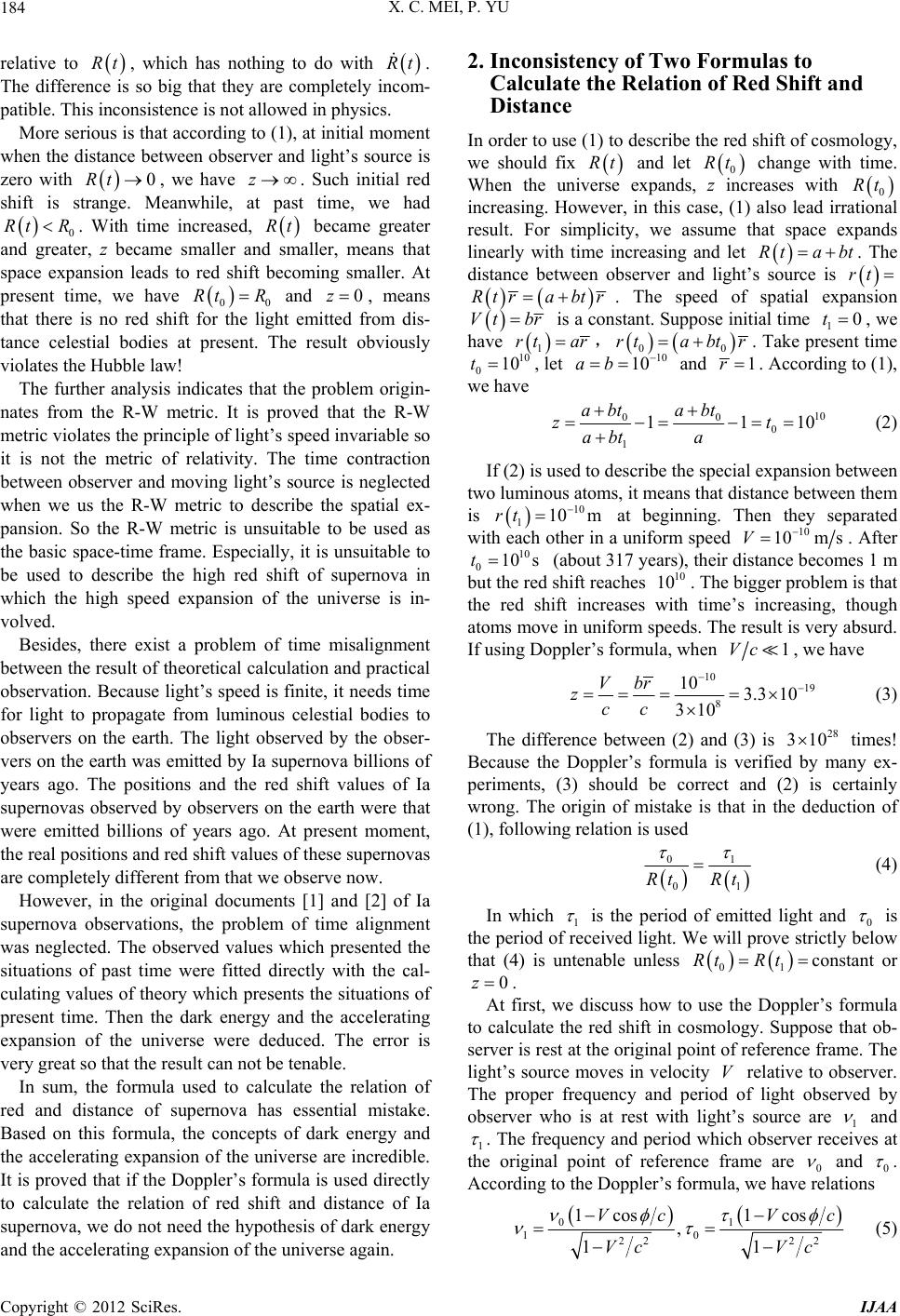 X. C. MEI, P. YU 184 relative to , which has nothing to do with Rt Rt . The difference is so big that they are completely incom- patible. This inconsistence is not allowed in physics. More serious is that according to (1), at initial moment when the distance between observer and light’s source is zero with , we have . Such initial red shift is strange. Meanwhile, at past time, we had . With time increased, became greater and greater, z became smaller and smaller, means that space expansion leads to red shift becoming smaller. At present time, we have and , means that there is no red shift for the light emitted from dis- tance celestial bodies at present. The result obviously violates the Hubble law! 0Rtz Rt 00 R 0 Rt R Rt 0z The further analysis indicates that the problem origin- nates from the R-W metric. It is proved that the R-W metric violates the principle of light’s speed invariable so it is not the metric of relativity. The time contraction between observer and moving light’s source is neglected when we us the R-W metric to describe the spatial ex- pansion. So the R-W metric is unsuitable to be used as the basic space-time frame. Especially, it is unsuitable to be used to describe the high red shift of supernova in which the high speed expansion of the universe is in- volved. Besides, there exist a problem of time misalignment between the result of theoretical calculation and practical observation. Because light’s speed is finite, it needs time for light to propagate from luminous celestial bodies to observers on the earth. The light observed by the obser- vers on the earth was emitted by Ia supernova billions of years ago. The positions and the red shift values of Ia supernovas observed by observers on the earth were that were emitted billions of years ago. At present moment, the real positions and red shift values of these supernovas are completely different from that we observe now. However, in the original documents [1] and [2] of Ia supernova observations, the problem of time alignment was neglected. The observed values which presented the situations of past time were fitted directly with the cal- culating values of theory which presents the situations of present time. Then the dark energy and the accelerating expansion of the universe were deduced. The error is very great so that the result can not be tenable. In sum, the formula used to calculate the relation of red and distance of supernova has essential mistake. Based on this formula, the concepts of dark energy and the accelerating expansion of the universe are incredible. It is proved that if the Doppler’s formula is used directly to calculate the relation of red shift and distance of Ia supernova, we do not need the hypothesis of dark energy and the accelerating expansion of the universe again. 2. Inconsistency of Two Formulas to Calculate the Relation of Red Shift and Distance In order to use (1) to describe the red shift of cosmology, we should fix Rt and let change with time. When the universe expands, z increases with 0 Rt 0 Rt bt increasing. However, in this case, (1) also lead irrational result. For simplicity, we assume that space expands linearly with time increasing and let . The distance between observer and light’s source is Rt a rt Rtr abtr. The speed of spatial expansion Vt br is a constant. Suppose initial time 10t , we have 1 rt ar, 0 rta bt r 10 10 0 . Take present time , let 10 010tab and 1r. According to (1), we have 10 00 0 1 11 abt abt zt abt a 10 (2) If (2) is used to describe the special expansion between two luminous atoms, it means that distance between them is 10 110 mrt at beginning. Then they separated with each other in a uniform speed 10 10m sV . After 0 (about 317 years), their distance becomes 1 m but the red shift reaches . The bigger problem is that the red shift increases with time’s increasing, though atoms move in uniform speeds. The result is very absurd. If using Doppler’s formula, when 10 10 st 10 10 1Vc, we have 10 19 8 10 3.310 310 Vbr zcc (3) The difference between (2) and (3) is times! Because the Doppler’s formula is verified by many ex- periments, (3) should be correct and (2) is certainly wrong. The origin of mistake is that in the deduction of (1), following relation is used 28 310 01 01 Rt Rt (4) In which 1 is the period of emitted light and 0 is the period of received light. We will prove strictly below that (4) is untenable unless constant or 01 Rt Rt 0z . At first, we discuss how to use the Doppler’s formula to calculate the red shift in cosmology. Suppose that ob- server is rest at the original point of reference frame. The light’s source moves in velocity relative to observer. The proper frequency and period of light observed by observer who is at rest with light’s source are 1 V and 1 . The frequency and period which observer receives at the original point of reference frame are 0 and 0 . According to the Doppler’s formula, we have relations 01 10 22 22 1cos 1cos , 11 Vc Vc Vc Vc (5) Copyright © 2012 SciRes. IJAA 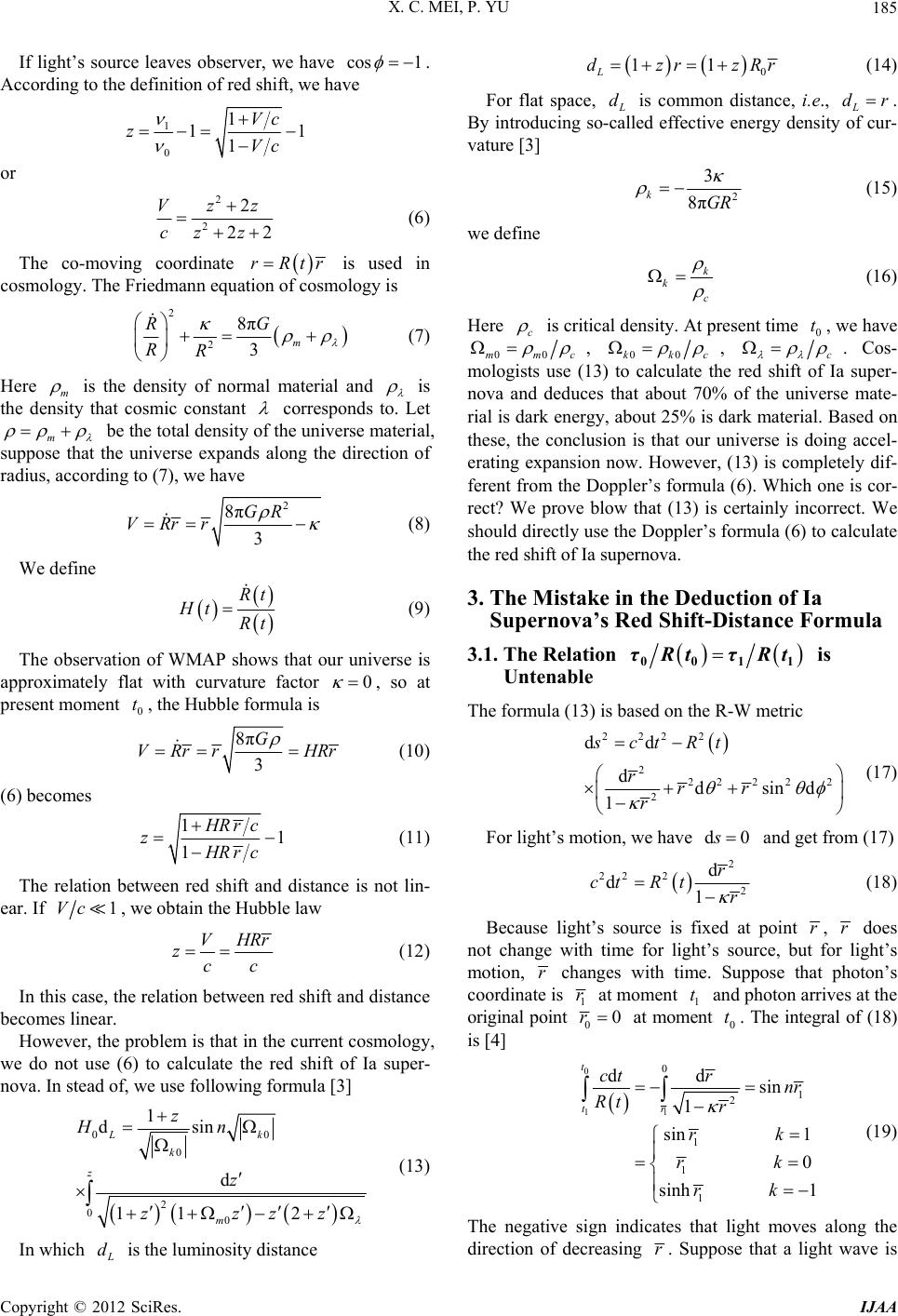 X. C. MEI, P. YU 185 If light’s source leaves observer, we have cos 1 . According to the definition of red shift, we have 1 0 1 11 1 Vc zVc or 2 2 2 22 Vzz czz (6) The co-moving coordinate rRtr is used in cosmology. The Friedmann equation of cosmology is 2 2 8π 3m RG RR (7) Here m is the density of normal material and is the density that cosmic constant corresponds to. Let m be the total density of the universe material, suppose that the universe expands along the direction of radius, according to (7), we have 2 8π 3 GR VRrr (8) We define Rt Ht Rt (9) The observation of WMAP shows that our universe is approximately flat with curvature factor , so at present moment , the Hubble formula is 0 0 t 8π 3 G VRrr HRr (10) (6) becomes 11 1 Rr c zHRrc (11) The relation between red shift and distance is not lin- ear. If 1Vc, we obtain the Hubble law VHRr zcc (12) In this case, the relation between red shift and distance becomes linear. However, the problem is that in the current cosmology, we do not use (6) to calculate the red shift of Ia super- nova. In stead of, we use following formula [3] 00 0 2 00 1 dsin d 11 2 Lk k z m z Hn z zzzz (13) In which d is the luminosity distance 0 11 L dzrzR r (14) For flat space, d is common distance, i.e., L dr . By introducing so-called effective energy density of cur- vature [3] 2 3 8π kGR (15) we define k kc (16) Here c is critical density. At present time , we have 0 t 00mmc , 00kkc , c . Cos- mologists use (13) to calculate the red shift of Ia super- nova and deduces that about 70% of the universe mate- rial is dark energy, about 25% is dark material. Based on these, the conclusion is that our universe is doing accel- erating expansion now. However, (13) is completely dif- ferent from the Doppler’s formula (6). Which one is cor- rect? We prove blow that (13) is certainly incorrect. We should directly use the Doppler’s formula (6) to calculate the red shift of Ia supernova. 3. The Mistake in the Deduction of Ia Supernova’s Red Shift-Distance Formula 3.1. The Relation τRt τRt 0011 is Untenable The formula (13) is based on the R-W metric 2222 2 222 22 2 dd ddsind 1 sctRt rrr r (17) For light’s motion, we have and get from (17) d0s 2 22 2 2 d d1 r ct Rtr (18) Because light’s source is fixed at point r, r does not change with time for light’s source, but for light’s motion, r changes with time. Suppose that photon’s coordinate is 1 r at moment 1 and photon arrives at the original point t 00r at moment . The integral of (18) is [4] 0 t 0 11 0 1 2 1 1 1 dd sin 1 sin 1 0 sinh 1 t tr ctr nr Rt r rk rk rk (19) The negative sign indicates that light moves along the direction of decreasing r. Suppose that a light wave is Copyright © 2012 SciRes. IJAA 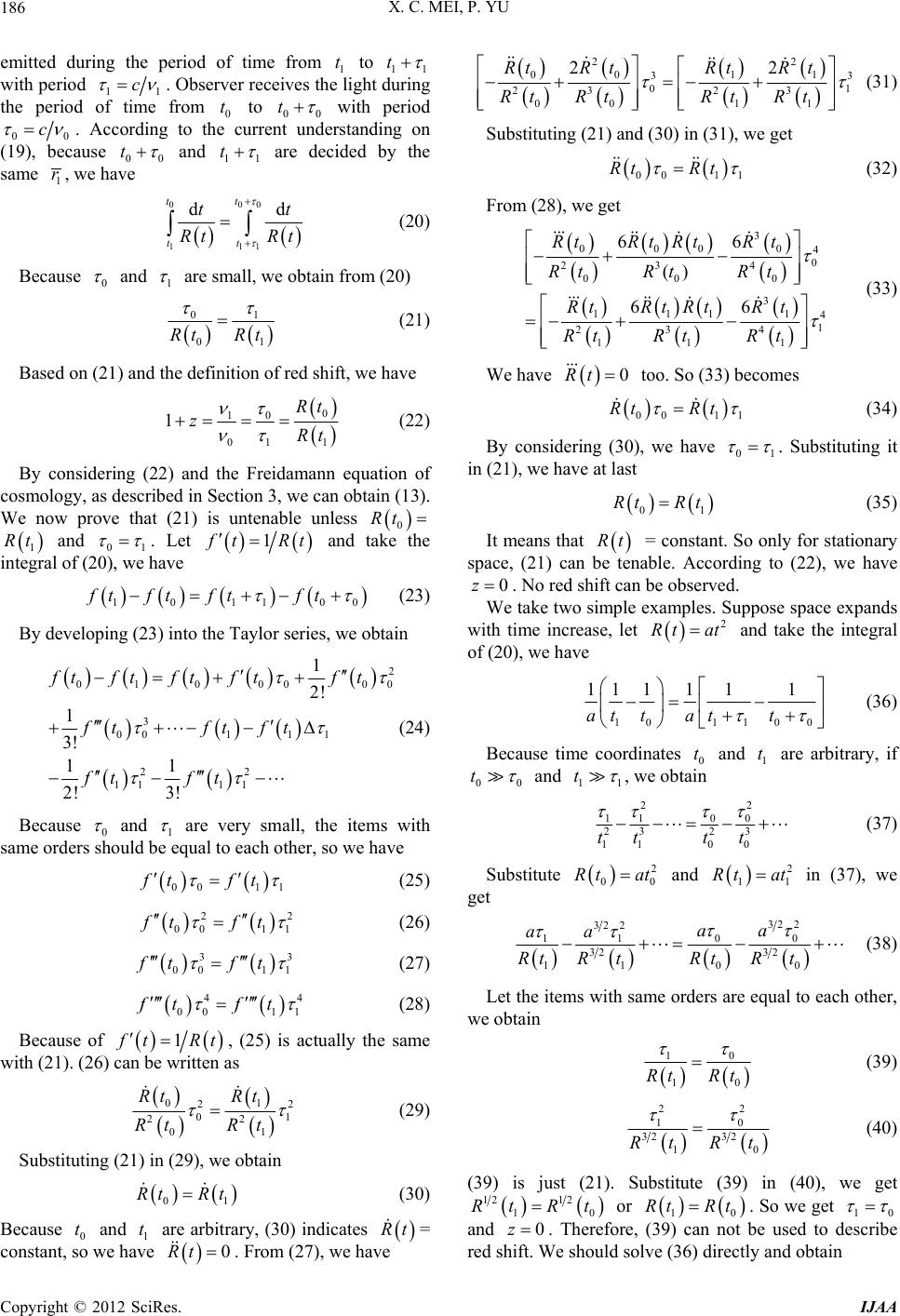 X. C. MEI, P. YU 186 emitted during the period of time from 1 to 11 t t with period 11 c . Observer receives the light during the period of time from 0 t to 00 t with period 00 c 0 . According to the current understanding on (19), because 0 t and 1 t1 are decided by the same 1 r, we have 00 11 d tt tt 0 1 d Rt Rt t t (20) Because 0 and 1 are small, we obtain from (20) 0 Rt 1 01 Rt (21) Based on (21) and the definition of red shift, we have 0 0 1 01 Rt zRt 1 1 (22) By considering (22) and the Freidamann equation of cosmology, as described in Section 3, we can obtain (13). We now prove that (21) is untenable unless 0 Rt and 01 1 Rt . Let 1 tR t and take the integral of (20), we have 10 ft 110 ftft ft 0 (23) By developing (23) into the Taylor series, we obtain 01 0 00 3 0011 1 22 11 11 1 2! 1 3! 11 2! 3! ftftftf tft ftft ft ft ft 2 00 (24) Because 0 and 1 are very small, the items with same orders should be equal to each other, so we have 00 11 tft (25) 2 00 11 ftft 2 (26) 3 00 11 ft ft3 (27) 4 00 11 ft ft4 (28) Because of 1 tRt , (25) is actually the same with (21). (26) can be written as 01 2 0 22 01 Rt Rt Rt Rt 2 1 (29) Substituting (21) in (29), we obtain 0 Rt Rt 1 (30) Because 0 and 1 are arbitrary, (30) indicates t t Rt = constant, so we have . From (27), we have 0Rt 22 00 11 33 01 23 23 00 11 22 RtR tRtR t RtRtRtRt (31) Substituting (21) and (30) in (31), we get 00 11 Rt Rt (32) From (28), we get 3 000 0 4 0 234 00 0 3 111 1 4 1 23 4 11 1 66 () 66 RtRt RtR t Rt RtRt RtRtRtRt Rt RtRt (33) We have 0Rt too. So (33) becomes 00 11 Rt Rt (34) By considering (30), we have 01 . Substituting it in (21), we have at last 0 Rt Rt1 (35) It means that Rt = constant. So only for stationary space, (21) can be tenable. According to (22), we have 0z . No red shift can be observed. We take two simple examples. Suppose space expands with time increase, let 2 Rt at and take the integral of (20), we have 10110 0 11 1111 at tatt 0 (36) Because time coordinates 0 and are arbitrary, if t1 t 0 t and 1 t1 , we obtain 2 2 00 11 23 23 11 00 tt tt (37) Substitute 2 0 Rt at01 and in (37), we get 2 1 Rt at 32 2 32 2 00 11 32 32 10 10 aa aa Rt Rt Rt Rt (38) Let the items with same orders are equal to each other, we obtain 0 1 10 Rt Rt (39) 2 2 0 1 32 32 10 Rt Rt (40) (39) is just (21). Substitute (39) in (40), we get 12 12 10 Rt Rt or 1 Rt Rt0 . So we get 10 and 0z . Therefore, (39) can not be used to describe red shift. We should solve (36) directly and obtain Copyright © 2012 SciRes. IJAA 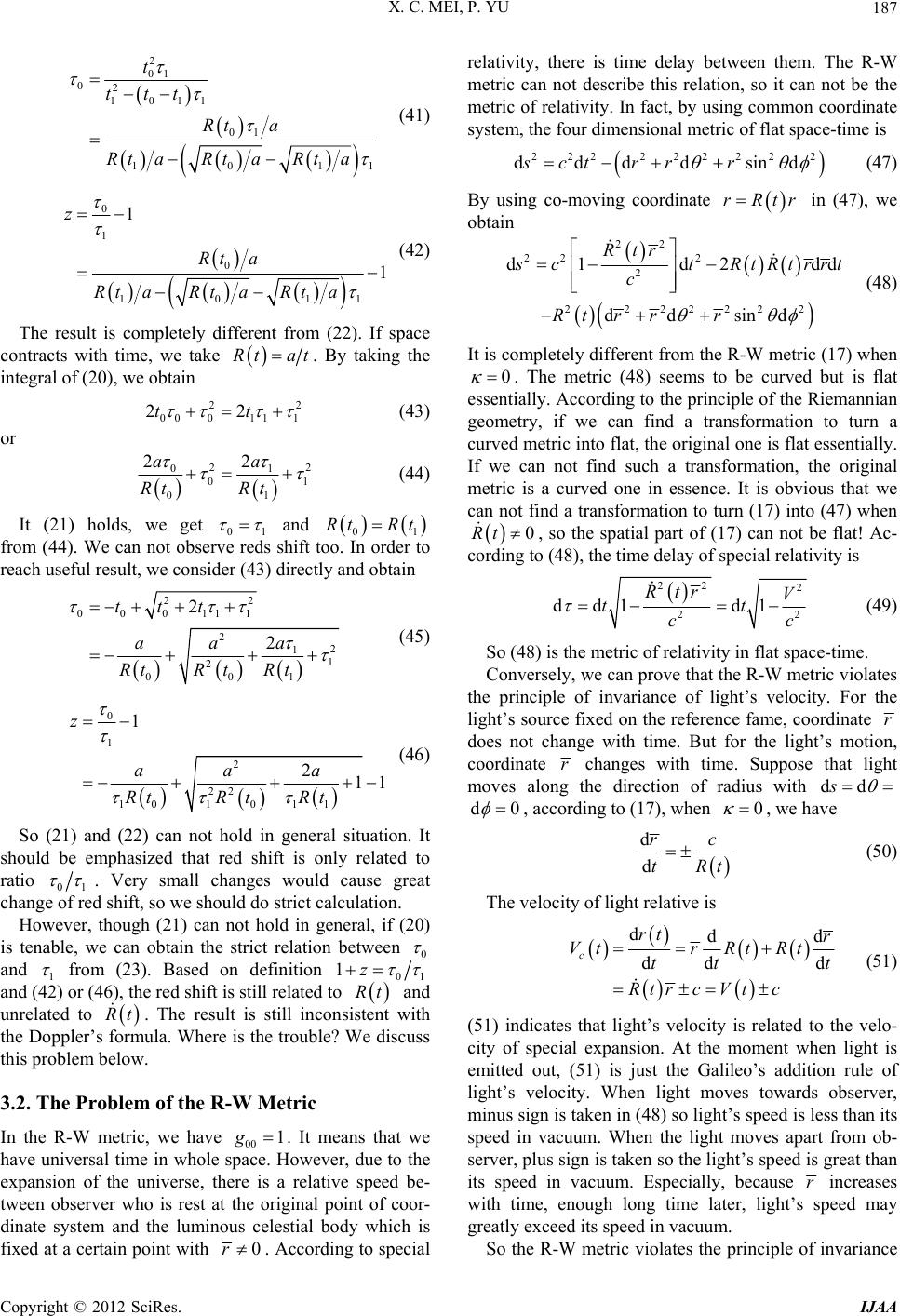 X. C. MEI, P. YU 187 2 01 02 1011 01 101 t ttt Rt a Rt aRtaRt a 1 (41) 0 1 0 101 1 1 z Rt a Rt aRtaRt a1 (42) The result is completely different from (22). If space contracts with time, we take Rt at. By taking the integral of (20), we obtain 2 000111 22tt 2 (43) or 2 01 0 01 22 aa Rt Rt 2 1 (44) It (21) holds, we get 01 and 01 Rt Rt from (44). We can not observe reds shift too. In order to reach useful result, we consider (43) directly and obtain 22 000111 2 2 1 1 2 01 0 2 2 ttt a aa Rt Rt Rt (45) 0 1 2 22 10 11 10 1 211 z aaa Rt Rt Rt (46) So (21) and (22) can not hold in general situation. It should be emphasized that red shift is only related to ratio 01 . Very small changes would cause great change of red shift, so we should do strict calculation. However, though (21) can not hold in general, if (20) is tenable, we can obtain the strict relation between 0 and 1 from (23). Based on definition 01 1z and (42) or (46), the red shift is still related to Rt and unrelated to . The result is still inconsistent with the Doppler’s formula. Where is the trouble? We discuss this problem below. Rt 3.2. The Problem of the R-W Metric In the R-W metric, we have 00 . It means that we have universal time in whole space. However, due to the expansion of the universe, there is a relative speed be- tween observer who is rest at the original point of coor- dinate system and the luminous celestial body which is fixed at a certain point with 1g 0r . According to special relativity, there is time delay between them. The R-W metric can not describe this relation, so it can not be the metric of relativity. In fact, by using common coordinate system, the four dimensional metric of flat space-time is 22222222 2 dddd sindsct rrr (47) By using co-moving coordinate rRtr in (47), we obtain 22 222 2 2222222 d1d2 d dd sind Rtr d ctRtR c Rt rrr trrt (48) It is completely different from the R-W metric (17) when 0 . The metric (48) seems to be curved but is flat essentially. According to the principle of the Riemannian geometry, if we can find a transformation to turn a curved metric into flat, the original one is flat essentially. If we can not find such a transformation, the original metric is a curved one in essence. It is obvious that we can not find a transformation to turn (17) into (47) when Rt 0 , so the spatial part of (17) can not be flat! Ac- cording to (48), the time delay of special relativity is 22 2 22 dd1d1 Rtr V tt cc (49) So (48) is the metric of relativity in flat space-time. Conversely, we can prove that the R-W metric violates the principle of invariance of light’s velocity. For the light’s source fixed on the reference fame, coordinate r does not change with time. But for the light’s motion, coordinate r changes with time. Suppose that light moves along the direction of radius with dds d0 , according to (17), when , we have 0 d d rc tRt (50) The velocity of light relative is ddd dd c rt r VtrRtRt tt Rtrc Vtc dt (51) (51) indicates that light’s velocity is related to the velo- city of special expansion. At the moment when light is emitted out, (51) is just the Galileo’s addition rule of light’s velocity. When light moves towards observer, minus sign is taken in (48) so light’s speed is less than its speed in vacuum. When the light moves apart from ob- server, plus sign is taken so the light’s speed is great than its speed in vacuum. Especially, because r increases with time, enough long time later, light’s speed may greatly exceed its speed in vacuum. So the R-W metric violates the principle of invariance Copyright © 2012 SciRes. IJAA  X. C. MEI, P. YU 188 of light’s velocity. This is not allowed in physics. As we know that the watershed between classical physics and modern physics is just on the invariance principle of light’s speed. Because the R-W metric violates this prin- ciple, it can not be used as the space-time frame for modern cosmology which is considered as the theory of relativity. Especially when the expansion speed of the universe is very high, huge error will be caused. Therefore, we should use (48) to describe light’s mo- tion in flat space-time. Suppose that light moves along the direction of radius, we have dd ds0 and obtain 22 22 2 22 1d 2ddd Rtr ct c RtRtrrtR tr 0 (52) d d Rtr r tRtR c t (53) By considering (53), light’s velocity is d dd dd d c Rtr rr VRtrRt tt t c (54) The result indicates that light’s speed is invariable. Similarly, the four dimensional metric in which three dimensional space has constant curvature is 2 2222222 2 2 d ddd sind 1 r sctr r r (55) By using co-moving coordinate in (55), we obtain 2 22 2 22 22 2 2222 22 2dd dd 11 ddsind 1 R tRtRttr sc t Rtr Rtr r Rtr r Rtr 22 (56) When light moves along the direction of radius, we have 22 22 22 22 2222 d 1 2dd d 0 11 Rtr ct Rtr RtRttrRt r Rtr Rtr (57) 22 1 d d cRtr Rtr r tRt Rt (58) If we use (53) and (58) to calculate the red shift of cosmology, the results are related to velocity. However, we can not separate variables in (53) and (58), so we can not write them in the simple form of (19). It is more convenient for us to use the Doppler’s formula directly to calculate the red shift of supernova in cosmology. On the other hand, as proved in document [5], when scalar factor Rt is related to time, the R-W metric has no constant curvature. By using the formula of the Riemannian geometry to do strict calculation, the space- time curvatures of the R-W metric actually are [5] 01 0203 2 12 13 232 R KKK R R KKKR (59) Here 0 is the curvature of space-time crossing parts and ij is the curvature of pure spatial parts. This result is completely different from the current understanding. Therefore, constant is not the factor of spatial curva- ture. It is a certain adjustable parameter. The R-W metric does not represent flat space-time when . It does not represent the metric of curved space with constant curvature too. It is improper for us to use the R-W metric to describe the expansion universe with zero or constant spatial curvature. 0 3.3. Time Misalignment Problem of Theoretical Calculation and Practical Observations Because light’s speed is finite, it needs time for light to propagate from luminous celestial bodies to observers on the earth. If the celestial body is far ways from the earth, the light may take billions of years to arrive at the ob- server. That is to say, light observed by observer on the earth was emitted billions of years ago. So the positions and the red shift values of Ia supernovas observed by observers at present on the earth were that of billions of years ago. At present moment, the real positions and the real red shift values of these supernovas are completely different from that we observe now. In the formulas (13), 0 , d, 0m and 0k are the values at present moment 0, therefore, (13) describe the relation between red shift and distance. However, Figure 1 describe the observed relation of red shift and distance of Ia supernova at past moments. Moreover, for the different points of curves in Figure 1, the times are different. In order to match times, we should transform all observation values at past moments to the value at present moment. Then fit them with the result of theory. Only in this way, the discussion can be meaningful. t However, in the original documents of supernova cos- mology projects, we have not found this kind of trans- formations. In stead, the observation values which repre- sent the red shifts and distances of supernova at past times are compared directly with theoretical values at present time. Then the conclusions of and 00.3 m 0.7 are deduced out. It is obvious that there is a problem of time match be- Copyright © 2012 SciRes. IJAA 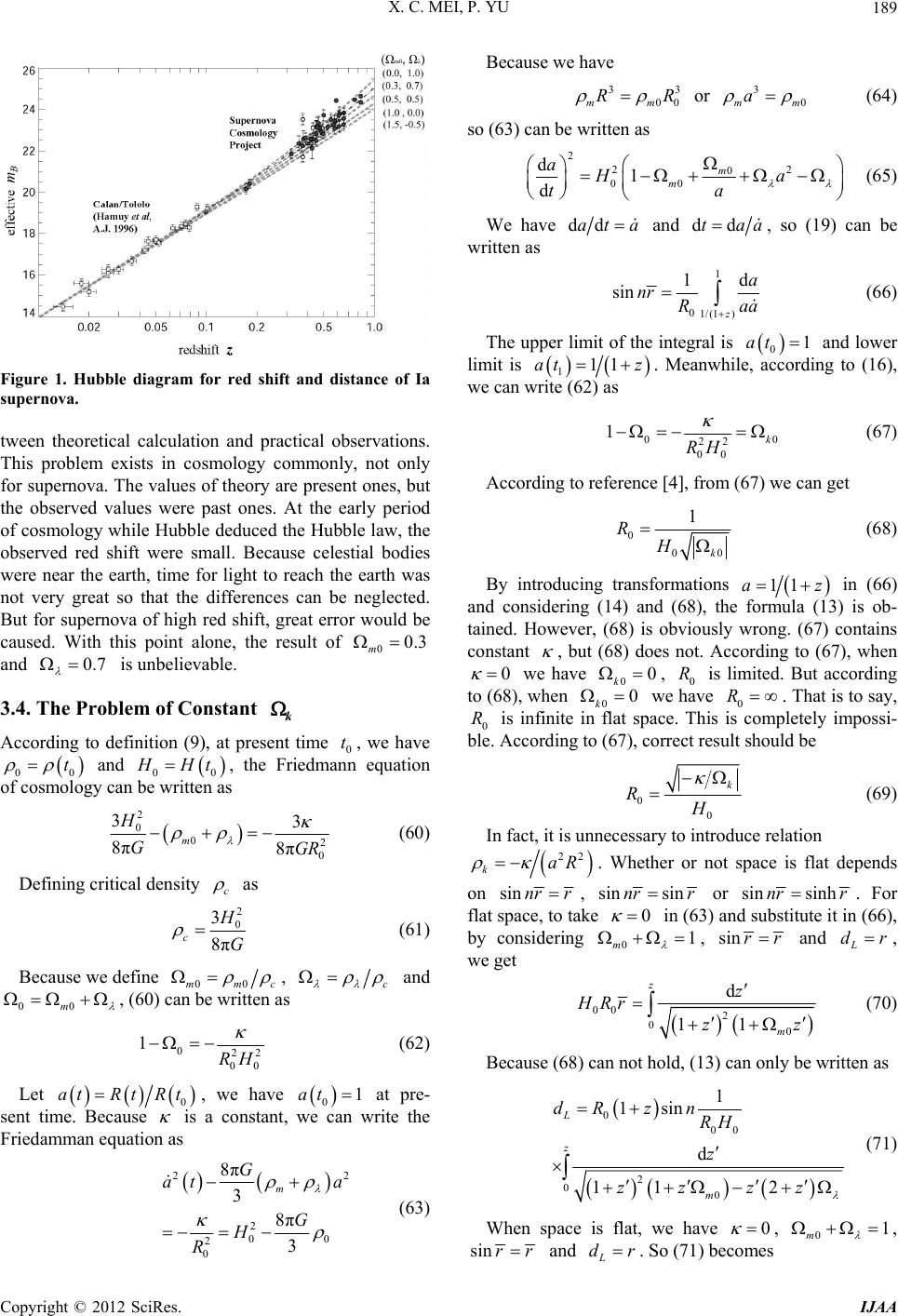 X. C. MEI, P. YU 189 Figure 1. Hubble diagram for red shift and distance of Ia supernova. tween theoretical calculation and practical observations. This problem exists in cosmology commonly, not only for supernova. The values of theory are present ones, but the observed values were past ones. At the early period of cosmology while Hubble deduced the Hubble law, the observed red shift were small. Because celestial bodies were near the earth, time for light to reach the earth was not very great so that the differences can be neglected. But for supernova of high red shift, great error would be caused. With this point alone, the result of 00.3 m and is unbelievable. 0.7 3.4. The Problem of Constant k According to definition (9), at present time 0, we have 0 and 0 t 0 t 0 Ht, the Friedmann equation of cosmology can be written as 2 0 02 0 33 8π8π m H GGR (60) Defining critical density c as 2 0 3 8π c G (61) Because we define 00mmc , c and 00m , (60) can be written as 022 00 1RH (62) Let 0 atRtRt, we have at pre- sent time. Because is a constant, we can write the Friedamman equation as 01at 22 2 00 2 0 8π 3 8π 3 m G at a G H R (63) Because we have 33 00 mm RR or 3 0 m am (64) so (63) can be written as 2 22 0 00 d1 d m m aHa ta (65) We have ddat a and ddta a, so (19) can be written as 1 01/(1 ) 1d sin z a nr Ra a (66) The upper limit of the integral is and lower limit is 01at 111at z . Meanwhile, according to (16), we can write (62) as 0 22 00 1k RH 0 (67) According to reference [4], from (67) we can get 0 00 1 k RH (68) By introducing transformations 11az in (66) and considering (14) and (68), the formula (13) is ob- tained. However, (68) is obviously wrong. (67) contains constant , but (68) does not. According to (67), when 0 we have 00 k 0 k , 0 is limited. But according to (68), when 0 R we have 0. That is to say, 0 is infinite in flat space. This is completely impossi- ble. According to (67), correct result should be R R 0 0 k RH (69) In fact, it is unnecessary to introduce relation 22 kaR . Whether or not space is flat depends on sin nr r , sin sinnrr or sin sinhnr r. For flat space, to take 0 in (63) and substitute it in (66), by considering 0m1 , sinrr and L dr , we get 00 2 00 d 11 z m z HRr zz (70) Because (68) can not hold, (13) can only be written as 0 00 2 00 1 1sin d 11 2 L z m dRz n RH z zz zz (71) When space is flat, we have , , 0 01 m sin rr and L dr . So (71) becomes Copyright © 2012 SciRes. IJAA 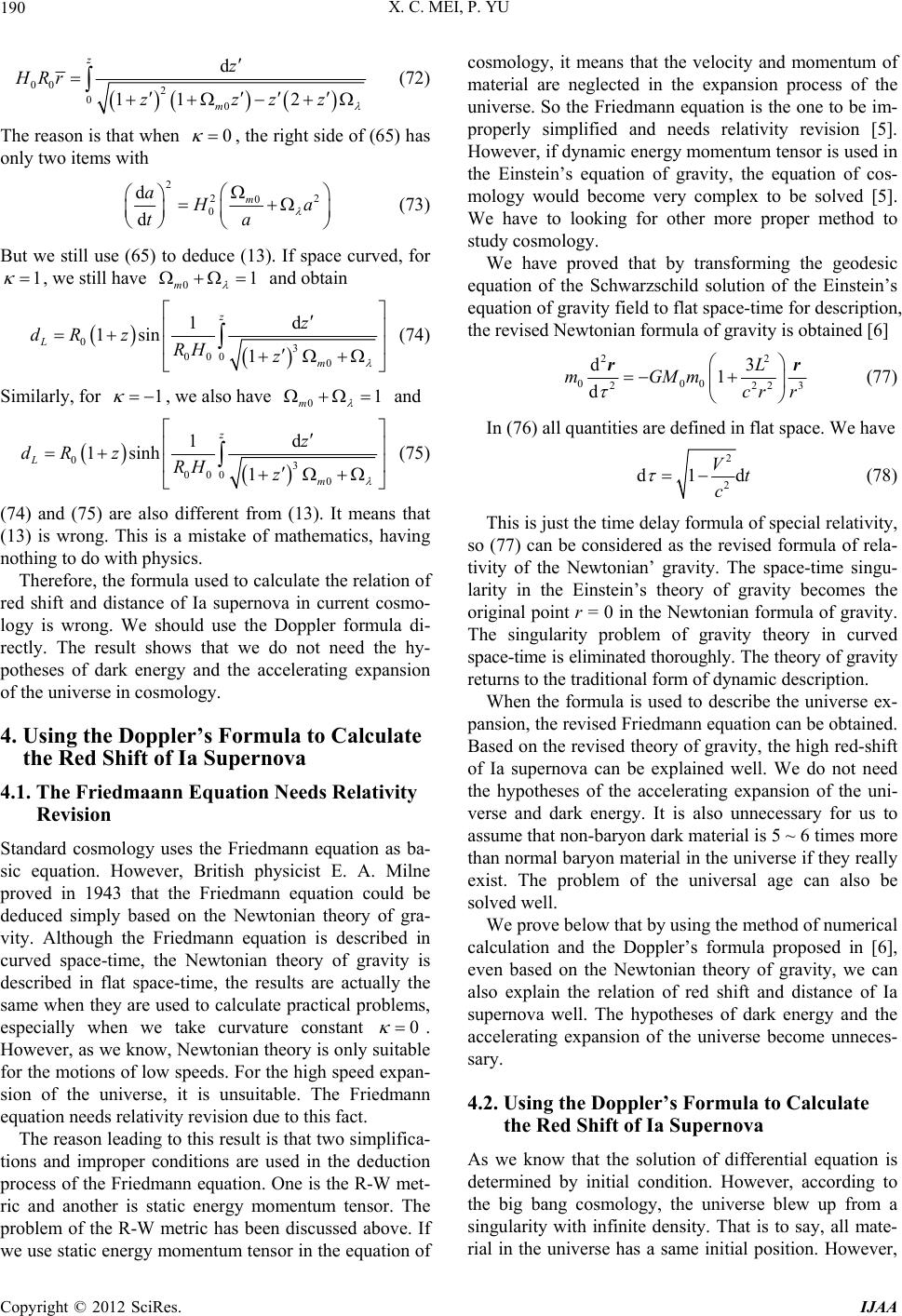 X. C. MEI, P. YU 190 00 2 00 d 11 2 z m z HRr zzzz (72) The reason is that when , the right side of (65) has only two items with 0 2 2 0 0 d d m a2 a ta (73) But we still use (65) to deduce (13). If space curved, for , we still have and obtain 1 01 m 03 000 0 1d 1sin 1 z L m z dR zRH z (74) Similarly, for , we also have and 1 01 m 03 000 0 1d 1sinh 1 z L m z dR zRHz (75) (74) and (75) are also different from (13). It means that (13) is wrong. This is a mistake of mathematics, having nothing to do with physics. Therefore, the formula used to calculate the relation of red shift and distance of Ia supernova in current cosmo- logy is wrong. We should use the Doppler formula di- rectly. The result shows that we do not need the hy- potheses of dark energy and the accelerating expansion of the universe in cosmology. 4. Using the Doppler’s Formula to Calculate the Red Shift of Ia Supernova 4.1. The Friedmaann Equation Needs Relativity Revision Standard cosmology uses the Friedmann equation as ba- sic equation. However, British physicist E. A. Milne proved in 1943 that the Friedmann equation could be deduced simply based on the Newtonian theory of gra- vity. Although the Friedmann equation is described in curved space-time, the Newtonian theory of gravity is described in flat space-time, the results are actually the same when they are used to calculate practical problems, especially when we take curvature constant 0 . However, as we know, Newtonian theory is only suitable for the motions of low speeds. For the high speed expan- sion of the universe, it is unsuitable. The Friedmann equation needs relativity revision due to this fact. The reason leading to this result is that two simplifica- tions and improper conditions are used in the deduction process of the Friedmann equation. One is the R-W met- ric and another is static energy momentum tensor. The problem of the R-W metric has been discussed above. If we use static energy momentum tensor in the equation of cosmology, it means that the velocity and momentum of material are neglected in the expansion process of the universe. So the Friedmann equation is the one to be im- properly simplified and needs relativity revision [5]. However, if dynamic energy momentum tensor is used in the Einstein’s equation of gravity, the equation of cos- mology would become very complex to be solved [5]. We have to looking for other more proper method to study cosmology. We have proved that by transforming the geodesic equation of the Schwarzschild solution of the Einstein’s equation of gravity field to flat space-time for description, the revised Newtonian formula of gravity is obtained [6] 22 000 2 d 1 d L mGMm cr r rr 2 23 3 (77) In (76) all quantities are defined in flat space. We have 2 2 d1 Vt c d (78) This is just the time delay formula of special relativity, so (77) can be considered as the revised formula of rela- tivity of the Newtonian’ gravity. The space-time singu- larity in the Einstein’s theory of gravity becomes the original point r = 0 in the Newtonian formula of gravity. The singularity problem of gravity theory in curved space-time is eliminated thoroughly. The theory of gravity returns to the traditional form of dynamic description. When the formula is used to describe the universe ex- pansion, the revised Friedmann equation can be obtained. Based on the revised theory of gravity, the high red-shift of Ia supernova can be explained well. We do not need the hypotheses of the accelerating expansion of the uni- verse and dark energy. It is also unnecessary for us to assume that non-baryon dark material is 5 ~ 6 times more than normal baryon material in the universe if they really exist. The problem of the universal age can also be solved well. We prove below that by using the method of numerical calculation and the Doppler’s formula proposed in [6], even based on the Newtonian theory of gravity, we can also explain the relation of red shift and distance of Ia supernova well. The hypotheses of dark energy and the accelerating expansion of the universe become unneces- sary. 4.2. Using the Doppler’s Formula to Calculate the Red Shift of Ia Supernova As we know that the solution of differential equation is determined by initial condition. However, according to the big bang cosmology, the universe blew up from a singularity with infinite density. That is to say, all mate- rial in the universe has a same initial position. However, Copyright © 2012 SciRes. IJAA 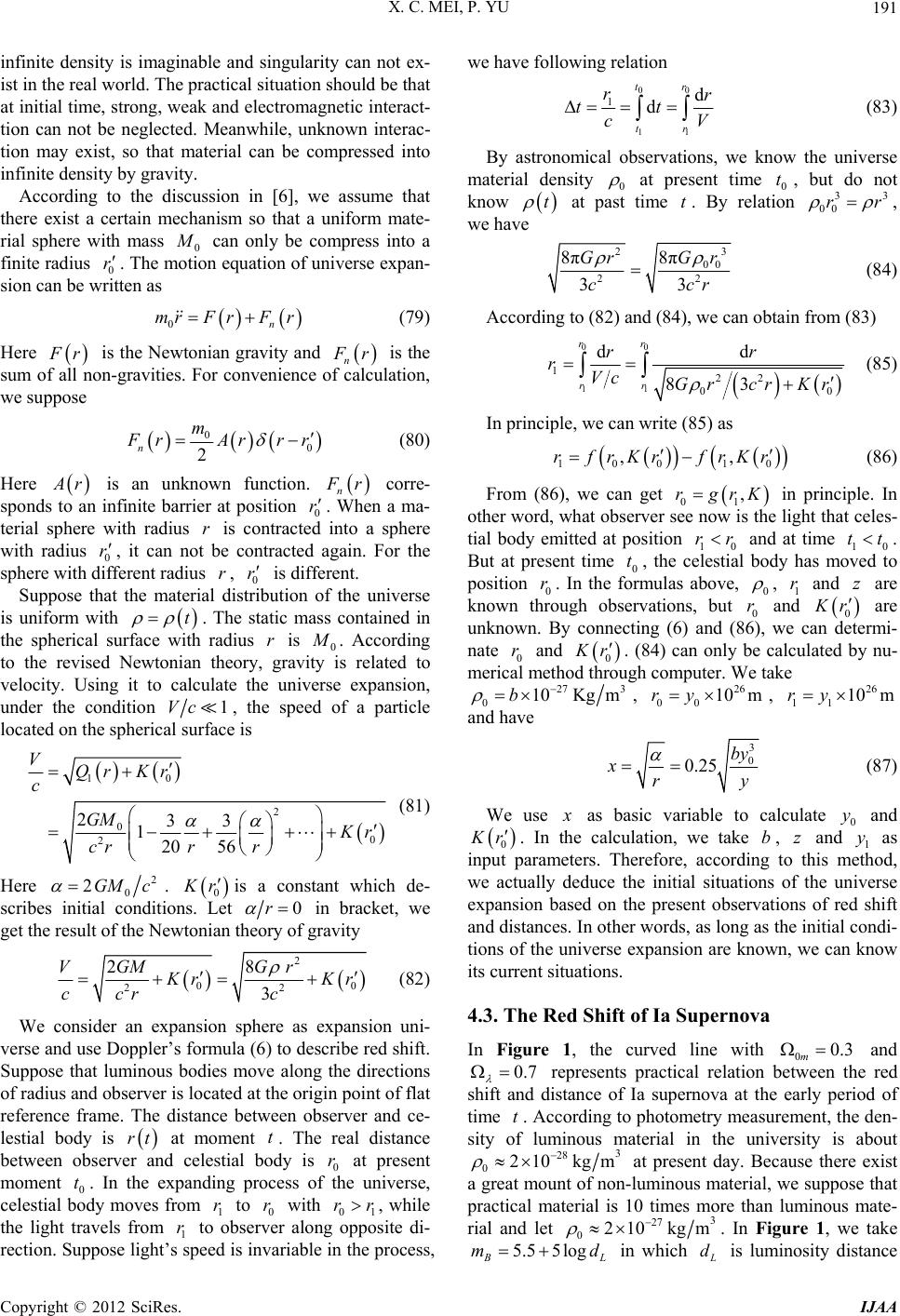 X. C. MEI, P. YU 191 infinite density is imaginable and singularity can not ex- ist in the real world. The practical situation should be that at initial time, strong, weak and electromagnetic interact- tion can not be neglected. Meanwhile, unknown interac- tion may exist, so that material can be compressed into infinite density by gravity. According to the discussion in [6], we assume that there exist a certain mechanism so that a uniform mate- rial sphere with mass 0 can only be compress into a finite radius 0. The motion equation of universe expan- sion can be written as r 0n mrFrFr (79) Here r is the Newtonian gravity and n r is the sum of all non-gravities. For convenience of calculation, we suppose 0 0 2 n m rArr r (80) Here r is an unknown function. n r corre- sponds to an infinite barrier at position 0. When a ma- terial sphere with radius is contracted into a sphere with radius 0, it can not be contracted again. For the sphere with different radius , is different. r r r r0 Suppose that the material distribution of the universe is uniform with . The static mass contained in the spherical surface with radius is 0 r t r . According to the revised Newtonian theory, gravity is related to velocity. Using it to calculate the universe expansion, under the condition 1Vc, the speed of a particle located on the spherical surface is 10 2 0 0 2 233 120 56 VQrKr c GM r rr cr (81) Here 2 0 2GM c . 0 ris a constant which de- scribes initial conditions. Let 0r in bracket, we get the result of the Newtonian theory of gravity 2 00 22 8 2 3 Gr VGM rK ccr c r (82) We consider an expansion sphere as expansion uni- verse and use Doppler’s formula (6) to describe red shift. Suppose that luminous bodies move along the directions of radius and observer is located at the origin point of flat reference frame. The distance between observer and ce- lestial body is at moment . The real distance between observer and celestial body is 0 at present moment 0. In the expanding process of the universe, celestial body moves from 1 to 0 r with 01 , while the light travels from 1 to observer along opposite di- rection. Suppose light’s speed is invariable in the process, we have following relation rt tr trrr r 00 11 1d d tr tr rr tt cV (83) By astronomical observations, we know the universe material density 0 at present time 0, but do not know t t at past time . By relation t33 00 rr , we have 3 2 00 2 8π 8π 33 Gr Gr cc 2 r (84) According to (82) and (84), we can obtain from (83) 00 11 122 00 dd 83 rr rr rr rVc Grcr Kr (85) In principle, we can write (85) as 100 10 ,,rfrKrfrKr (86) From (86), we can get in principle. In other word, what observer see now is the light that celes- tial body emitted at position 10 and at time 10 01 ,rgrK rr tt . But at present time 0, the celestial body has moved to position 0. In the formulas above, 0 t r , 1 and are known through observations, but 0 and r z r 0 r are unknown. By connecting (6) and (86), we can determi- nate 0 and r 0 r . (84) can only be calculated by nu- merical method through computer. We take 27 Kg m 3 0, , and have 10 b 26 00 10 mry 26 10 m 11 ry 3 0 0.25by xry (87) We use as basic variable to calculate 0 and y 0 r . In the calculation, we take b, and 1 as input parameters. Therefore, according to this method, we actually deduce the initial situations of the universe expansion based on the present observations of red shift and distances. In other words, as long as the initial condi- tions of the universe expansion are known, we can know its current situations. z y 4.3. The Red Shift of Ia Supernova In Figure 1, the curved line with 0 and 0.3 m 0.7 t represents practical relation between the red shift and distance of Ia supernova at the early period of time . According to photometry measurement, the den- sity of luminous material in the university is about 3 28 021 0 kgm at present day. Because there exist a great mount of non-luminous material, we suppose that practical material is 10 times more than luminous mate- rial and let 3 27 0210kgm . In Figure 1, we take 5.5 5log L md in which d is luminosity distance Copyright © 2012 SciRes. IJAA 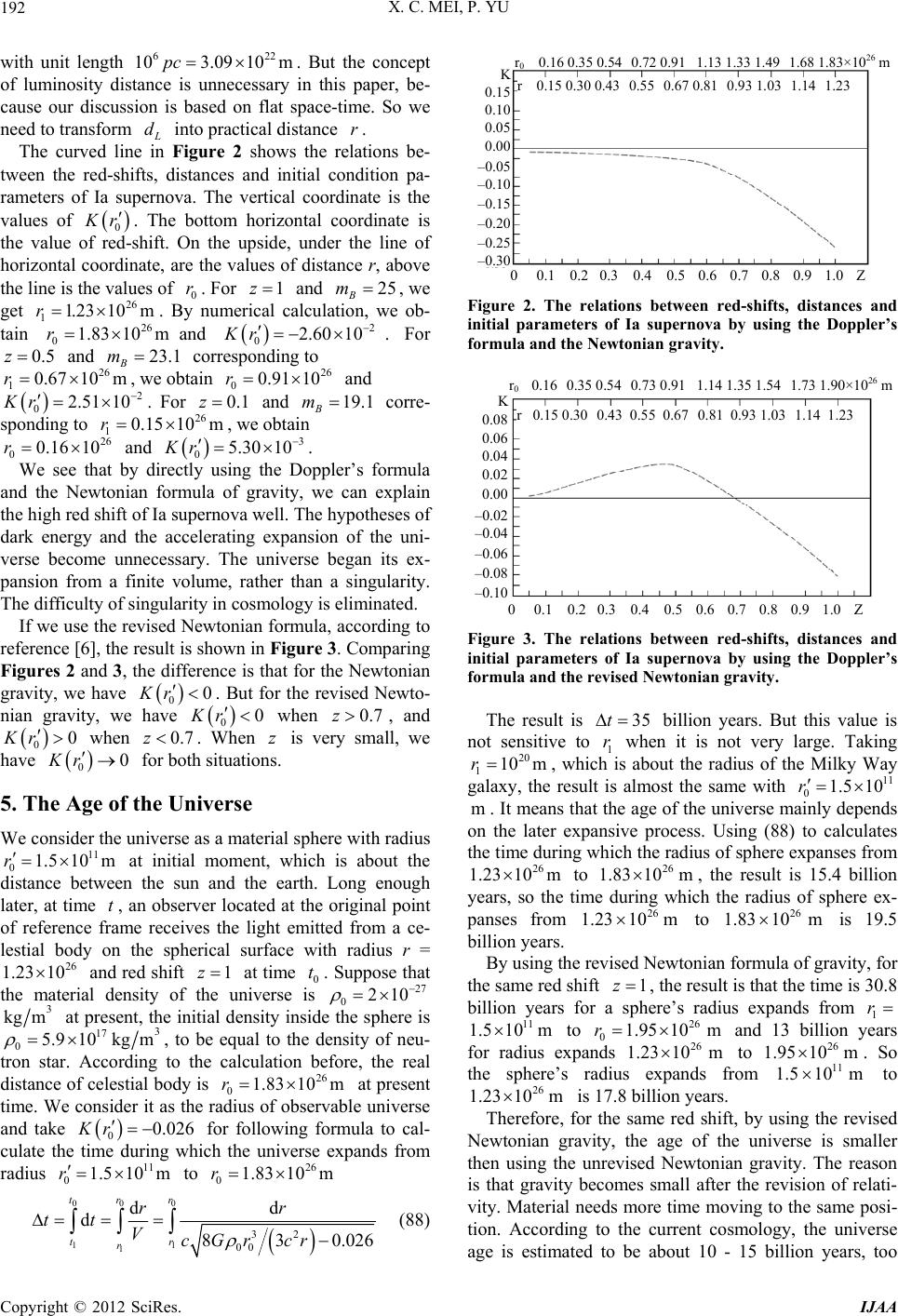 X. C. MEI, P. YU 192 with unit length . But the concept of luminosity distance is unnecessary in this paper, be- cause our discussion is based on flat space-time. So we need to transform 6 103.0910mpc 22 d into practical distance r. The curved line in Figure 2 shows the relations be- tween the red-shifts, distances and initial condition pa- rameters of Ia supernova. The vertical coordinate is the values of 0 r. The bottom horizontal coordinate is the value of red-shift. On the upside, under the line of horizontal coordinate, are the values of distance r, above the line is the values of 0. For and r1z25 B m , we get . By numerical calculation, we ob- tain and 0 26 m 26 10 m Kr 11.r 0 r23 10 1.83 2 2.60 10 23.1 00.91r 20.1z 26 0.15 10m 3 05.30 10Kr 00Kr 00Kr 0.7zz 1z 26 .1 . For and corresponding to , we obtain and 0. For and corre- sponding to , we obtain and . 0.5 0.67 0.16 z 1 r Kr 0 r B m 26 10 m 2.51 10 1 r 26 10 10 B m19 0 We see that by directly using the Doppler’s formula and the Newtonian formula of gravity, we can explain the high red shift of Ia supernova well. The hypotheses of dark energy and the accelerating expansion of the uni- verse become unnecessary. The universe began its ex- pansion from a finite volume, rather than a singularity. The difficulty of singularity in cosmology is eliminated. If we use the revised Newtonian formula, according to reference [6], the result is shown in Figure 3. Comparing Figures 2 and 3, the difference is that for the Newtonian gravity, we have . But for the revised Newto- nian gravity, we have when , and when . When is very small, we have for both situations. 0.7z 00Kr 0 Kr 0 5. The Age of the Universe We consider the universe as a material sphere with radius at initial moment, which is about the distance between the sun and the earth. Long enough later, at time , an observer located at the original point of reference frame receives the light emitted from a ce- lestial body on the spherical surface with radius r = and red shift at time 0. Suppose that the material density of the universe is 11 01.5 10 mr t 26 1.23 10t 27 210 3 kg m at present, the initial density inside the sphere is 3 17 k 0 Kr 5 0, to be equal to the density of neu- tron star. According to the calculation before, the real distance of celestial body is 0 at present time. We consider it as the radius of observable universe and take for following formula to cal- culate the time during which the universe expands from radius to r 5.9 1 0 r 0 g 1.1 m 0. 11 0 m 26 10 26 0 m 1.83 1.83 1 m r 6 0 02 00 0 11 1 32 00 dd d 830.02 r 6 r r tt cGr cr trr tr V (88) 0 0.16 0.35 0.54 0.72 0.91 1.13 1.33 1.49 1.681.83×10 26 m r 0.15 0.30 0.43 0.55 0.67 0.81 0.93 1.03 1.14 1.23 K 0.15 0.10 0.05 0.00 –0.05 –0.10 –0.15 –0.20 –0.25 0.30 0 0.1 0.2 0.3 0.4 0.5 0.6 0.7 0.8 0.9 1.0 Z Figure 2. The relations between red-shifts, distances and initial parameters of Ia supernova by using the Doppler’s formula and the Newtonian gravity. 0 0.16 0.35 0.54 0.73 0.91 1.14 1.35 1.54 1.73 1.90×10 26 m r 0.15 0.30 0.43 0.55 0.67 0.81 0.93 1.03 1.14 1.23 K 0.08 0.06 0.04 0.02 0.00 –0.02 –0.04 –0.06 –0.08 0.10 0 0.1 0.2 0.3 0.4 0.5 0.6 0.7 0.8 0.9 1.0 Z Figure 3. The relations between red-shifts, distances and initial parameters of Ia supernova by using the Doppler’s formula and the revised Newtonian gravity. The result is 35t r 1.8310 26 1.23 10 billion years. But this value is not sensitive to 1 when it is not very large. Taking , which is about the radius of the Milky Way galaxy, the result is almost the same with . It means that the age of the universe mainly depends on the later expansive process. Using (88) to calculates the time during which the radius of sphere expanses from to , the result is 15.4 billion years, so the time during which the radius of sphere ex- panses from to is 19.5 billion years. 20 110mr m 26 1.23 10m 11 01.5 10r 26 m 26 m m1.83 10 By using the revised Newtonian formula of gravity, for the same red shift 1z , the result is that the time is 30.8 billion years for a sphere’s radius expands from 1 r to and 13 billion years for radius expands to . So the sphere’s radius expands from to is 17.8 billion years. 11 1.5 10m 26 1.23 10m 26 010 mr 26 10 m 1.95 1.23 26 1.95 10m 11 1.5 10m Therefore, for the same red shift, by using the revised Newtonian gravity, the age of the universe is smaller then using the unrevised Newtonian gravity. The reason is that gravity becomes small after the revision of relati- vity. Material needs more time moving to the same posi- tion. According to the current cosmology, the universe age is estimated to be about 10 - 15 billion years, too Copyright © 2012 SciRes. IJAA 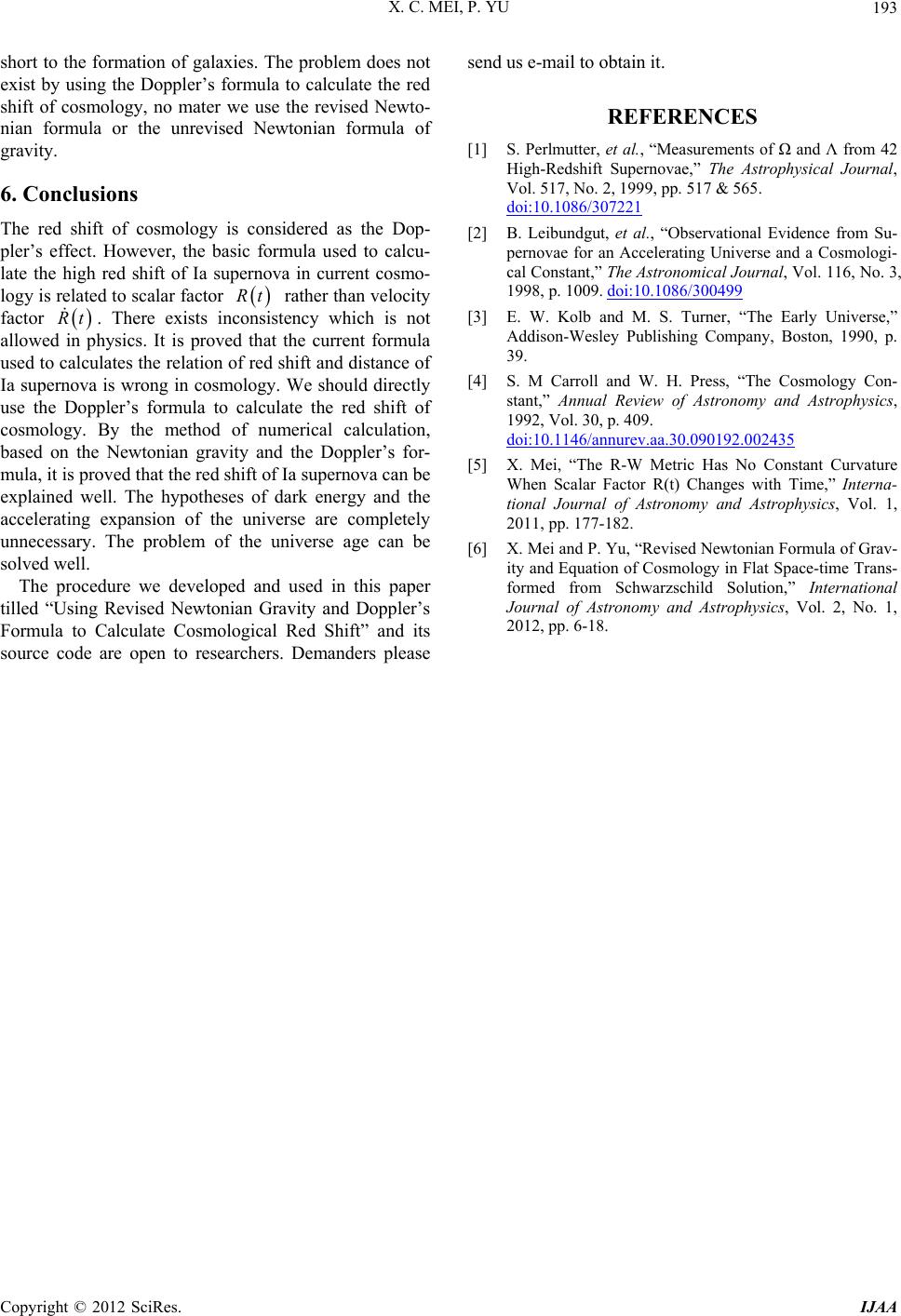 X. C. MEI, P. YU Copyright © 2012 SciRes. IJAA 193 short to the formation of galaxies. The problem does not exist by using the Doppler’s formula to calculate the red shift of cosmology, no mater we use the revised Newto- nian formula or the unrevised Newtonian formula of gravity. 6. Conclusions The red shift of cosmology is considered as the Dop- pler’s effect. However, the basic formula used to calcu- late the high red shift of Ia supernova in current cosmo- logy is related to scalar factor rather than velocity factor . There exists inconsistency which is not allowed in physics. It is proved that the current formula used to calculates the relation of red shift and distance of Ia supernova is wrong in cosmology. We should directly use the Doppler’s formula to calculate the red shift of cosmology. By the method of numerical calculation, based on the Newtonian gravity and the Doppler’s for- mula, it is proved that the red shift of Ia supernova can be explained well. The hypotheses of dark energy and the accelerating expansion of the universe are completely unnecessary. The problem of the universe age can be solved well. Rt Rt The procedure we developed and used in this paper tilled “Using Revised Newtonian Gravity and Doppler’s Formula to Calculate Cosmological Red Shift” and its source code are open to researchers. Demanders please send us e-mail to obtain it. REFERENCES [1] S. Perlmutter, et al., “Measurements of Ω and Λ from 42 High-Redshift Supernovae,” The Astrophysical Journal, Vol. 517, No. 2, 1999, pp. 517 & 565. doi:10.1086/307221 [2] B. Leibundgut, et al., “Observational Evidence from Su- pernovae for an Accelerating Universe and a Cosmologi- cal Constant,” The Astronomical Journal, Vol. 116, No. 3, 1998, p. 1009. doi:10.1086/300499 [3] E. W. Kolb and M. S. Turner, “The Early Universe,” Addison-Wesley Publishing Company, Boston, 1990, p. 39. [4] S. M Carroll and W. H. Press, “The Cosmology Con- stant,” Annual Review of Astronomy and Astrophysics, 1992, Vol. 30, p. 409. doi:10.1146/annurev.aa.30.090192.002435 [5] X. Mei, “The R-W Metric Has No Constant Curvature When Scalar Factor R(t) Changes with Time,” Interna- tional Journal of Astronomy and Astrophysics, Vol. 1, 2011, pp. 177-182. [6] X. Mei and P. Yu, “Revised Newtonian Formula of Grav- ity and Equation of Cosmology in Flat Space-time Trans- formed from Schwarzschild Solution,” International Journal of Astronomy and Astrophysics, Vol. 2, No. 1, 2012, pp. 6-18.
|